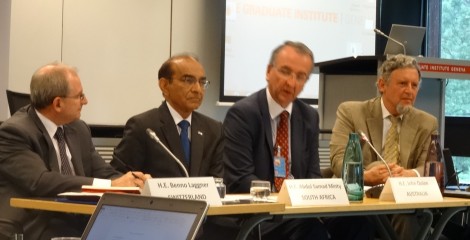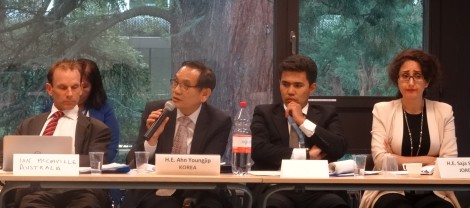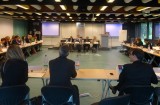On 1 September 2015, representatives from twenty-two governments* joined a small group of disarmament experts and representatives of international organisations at a roundtable conference in Geneva to discuss diplomatic approaches to nuclear-related conflicts, and proposals for multilateral nuclear disarmament. The roundtable included a range of States, including some that possess nuclear weapons, some that are part of nuclear-security alliances, and some non-nuclear-weapon States (see * below for full list).
The event was organised by the Middle Powers Initiative (MPI), Parliamentarians for Nuclear Non-Proliferation and Disarmament (PNND), Basel Peace Office and Friedrich-Ebert-Stiftung Geneva Office as part of the Framework Forum – a process engaging governments in building the framework for a nuclear-weapon-free world. Previous Framework Forum roundtables have been organised in Vienna (May, 2012), New York (Oct, 2012), Berlin (Feb, 2013) and Geneva (August 2013, September 2014).
Entitled From the NPT to the UN General Assembly: Filling the legal gap to prohibit and eliminate nuclear weapons, the roundtable aimed to a) pick up on some of the key developments from the 2015 Non-proliferation Treaty Review Conference held in April-May 2015, and b) feed into the deliberations and draft resolutions of the First Committee (Disarmament and International Security) of the UN General Assembly in October 2015.

Tarja Cronberg (Moddle Powers Initiative), Hannah Peters (Friedrich-Ebert-Stiftung), Alyn Ware (PNND), H.E. Triyono Wibowo (Indonesia) and Annika Thunborg (Sweden)
Despite the failure of the 2015 NPT Review Conference to adopt a final agreed document, some real gains were made during the four weeks of negotiations. There were a number of initiatives and proposals in the Draft Final Report of the Chairman of the 1st Committee (May 15) and the NPT 2015 draft final document (May 21) that had either general agreement or widespread support by NPT Parties. These included reference to the humanitarian imperative to achieve nuclear disarmament, and various options to establish the legal framework for the prohibition and elimination of nuclear weapons, which were outlined in a New Agenda Coalition working paper. The Draft Final Report of the Chairman of the 1st Committee also included a recommendation for mutually reinforcing building blocks that could be realized simultaneously. Many of these were outlined in the NPT working paper Building blocks for a world without nuclear weapons.
The NPT 2015 Draft Final Document also included a recommendation that the UN General Assembly establish an Open Ended Working Group to identify and elaborate effective measures for the full implementation of Article VI of the NPT, including legal provisions required to achieve a nuclear-weapon-free world.
However, many delegations at the 2015 NPT Review Conference also highlighted security issues, including regional conflicts, which need to be considered in order to relinquish reliance on nuclear weapons and to prohibit and eliminate them. The recent re-affirming and strengthening of nuclear threat postures between Russia and NATO/USA reinforce the point that security issues are an important consideration. On the other hand, the success of the Iran negotiations demonstrates that nuclear-related conflicts can be resolved, and that this can support nuclear non-proliferation and assist nuclear disarmament.

H.E. Benno Laggner (Switzerland), H.E. Abdul Minty (South Africa), H.E. John Quinn (Australia) and Aaron Tovish (Mayors for Peace)
The Framework Forum roundtable, picking up on these issues, held three sessions on the topics:
-
Nuclear disarmament and security issues;
-
Options to fill the legal gap & practical measures to achieve a nuclear-weapon-free world;
-
United Nations processes including an Open Ended Working Group.
Nuclear disarmament and security issues
Tarja Cronberg, Chair of the Middle Powers Initiative and former Chair of the European Parliament Contact Group with Iran, outlined key elements of the recent deal between Iran and the P5+1 and European Union. Ms Cronberg also discussed the diplomatic approaches that helped build success, and the need for continued support to ensure that the deal holds – and is implemented by all parties - in the face of opposition to it from conservative forces particularly in Iran and the United States. A key lesson from the deal is that it is possible to reach agreement between States that are hostile to each other by utilizing sound an defective diplomatic approaches as long as there is sufficient good faith from the key parties. This could have lessons for other nuclear related conflicts including that between Russia and the West, and the conflicts in the China Sea.
Marc Finaud, Senior Advisor for the Emerging Security Challenges Programme at the Geneva Centre for Security Policy, discussed the complexities of nuclear-related security issues in Europe, but argued that it is a responsibility of all states concerned to “continue to review their military and security concepts, doctrines and policies over the course of the next review cycle, with a view to reducing further the role and significance of nuclear weapons.’ Mr Finaud indicated that ‘this applies not only to nuclear-weapon states but also to states benefiting from extended nuclear deterrence and/or having US nuclear weapons deployed on their territories.’ Mr Finaud warned that the escalating conflict between Russia and NATO has led to a strengthening of reliance on nuclear weapons – rather than a reduction in such reliance. Finaud highlighted an immediate need for confidence building measures in order to reduce the security and nuclear risks arising from this conflict. He noted that it would be very unlikely for NATO as a whole to reduce reliance on nuclear weapons at this time – and therefore actions by individual NATO states in this direction is important. This could include unilateral repatriation of US deployed nuclear weapons by one or more of the NATO nuclear-sharing states. He provided examples of such leadership in the past, such as the unilateral decision by German Chancellor Helmut Kohl to remove the joint US-West German Pershing 1a systems that facilitated the conclusion of the historic INF Treaty between the US and the Soviet Union in 1987, and he commented that ‘Hiding behind the need for consensus within the Alliance or the current NATO Strategic Concept would only confirm a lack of political courage or vision as opposed to the leadership displayed by leaders in the more difficult times of the Cold War.”

Marc Finaud (Geneva Centre for Security Policy)
Uta Zapf, PNND Special Representative to Inter-parliamentary organisations, spoke about the important role of parliamentarians to support cooperative security approaches to resolving conflicts and tensions in order to support the elimination of reliance on nuclear weapons. Ms Zapf noted that the Organisation for Security and Cooperation in Europe (OSCE) and the Parliamentary Assembly of the OSCE provide important forums and mechanisms to manage conflicts and advance cooperative security approaches. PNND has been active in the OSCE Parliamentary Assembly – in dialogue with parliamentarians from Russia, Ukraine, USA and other NATO countries, all of which are represented in the Assembly. PNND has highlighted - in OSCE PA side events and proposed text for the annual declarations - the risks of nuclear weapons use and the humanitarian consequences of any such use. PNND has also highlighted cooperative security approaches and proposals for multilateral nuclear disarmament negotiations including through a United Nations Open Ended Working Group. The fact that PNND’s proposed text has been adopted by consensus in a number of the OSCE PA annual declarations indicates the potential for success of these approaches. On the other hand, resolutions by inter-parliamentary bodies are not binding on the governments – and more work has to be done to increase the public and political attention to these initiatives.
There were a number of points made in the discussion – including what impact the humanitarian initiative has had, or could have, on reducing the role of nuclear weapons in security doctrines. One response to this was that the humanitarian initiative has been very important in highlighting the risks and consequences of any nuclear weapons use and has probably helped strengthen a norm of non-use, but that it has not really dented the nuclear deterrence doctrine which holds that possessing the weapons and threatening their use is vital in order to prevent aggression and/or the use of nuclear weapons by a hostile state. It may provide an imperative to achieve a nuclear weapon-free world, but it does not provide a security framework that would enable nuclear abolition.
Options to fill the legal gap & practical measures to achieve a nuclear-weapon-free world;
Ambassador Abdul Minty, Permanent Representative of South Africa to the United Nations in Geneva, gave an impassioned speech on the need for all states to negotiate bold measures for nuclear disarmament. He critiqued the reliance of the nuclear-armed States on nuclear weapons, noting that the majority of the world have already chosen not to base their security on nuclear weapons, and there is no valid reason for the more powerful states not to do the same. He noted that the nuclear armed States are failing in the nuclear disarmament obligations and this is impacting negatively on the security of everyone.
Ambassador John Quinn, Permanent Representative of Australia to the UN in Geneva, outlined the 'building blocks' approach which had been presented to the Open Ended Working Group in 2013 by a group of countries including Australia. The approach can complement the 'step-by-step' approach, by forseeing the possiblity of parallel and simultaneous work on various steps. Ambassador Quinn noted that the final measures for reaching a nuclear-weapon-free world will need to be multi-lateral, However, initial 'building blocks' could be a combination of unilateral, bilateral, plurilateral and multilateral measures.
Aaron Tovish, Director of the Mayors for Peace 2020 Vision Campaign, discussed the need for a concrete nuclear disarmament plan – or framework. He noted that a step-by-step approach without such a plan is bound to fail. He compared nuclear disarmament with building a bookshelf or cabinet. If one started with a few pieces of wood for the bottom, with no plan for how the whole cabinet would look, then we would have little idea of whether the base is suitable for the latter structure. Nor would we know what pieces to add next. Mr Tovish noted that IKEA has a good kitset for building cabinets – which includes a plan on what the cabinet will look like and preparatory work on the pieces which are designed in accordance with the plan. There are still steps to put all the pieces together, but they are guided by the plan.

PAX - an IKEA brand cabinet. Building one could be an analogy for building a nuclear-weapon-free world
In the discussion period, there were several comments on the framework approach to nuclear disarmament and the cabinet analogy. One was that the framework approach, like the building blocks approach, lent itself to the possibility of different states working on different elements (building blocks),– using their interest or speciality – rather than everyone having to work on the same parts. However, it was noted that this would only work if there was an agreed framework amongst all states. This idea is explored further in the ILPI paper On Builders and Blockers which was referenced as one of the background papers for the roundtable.
It was also noted that there is not really a legal gap with regard to nuclear weapons - as IHL already prohibits the use of nuclear weapons and there is already a legal obligation to achieve comprehensive nuclear disarmament. Rather there is an implementation gap. (See Legal Gap or Compliance Gap? John Burroughs and Peter Weiss, Arms Control Today, October 2015)
United Nations processes including an Open Ended Working Group
Annika Thunborg, Deputy Director-General and Acting Head of Department in the Foreign Ministry of Sweden, reported on the success of the Open Ended Working Group in 2013, and the value of another OEWG in 2016 to continue and extend the work. However, Ms Thunborg indicated that if the OEWG was to be re-established in 2016, it would be important for it to look at how to engage more of the nuclear-armed states. Non-nuclear states can take some measures to strengthen the norms against nuclear weapons and to build political impetus for nuclear disarmament, but nuclear armed states have to be involved in order to reduce the risks of nuclear weapons use and to achieve a nuclear-weapon free world.
Ambassador Triyono Wibowo, Permanent Representative of Indonesia to the United Nations in Geneva, outlined some of the initiatives taken by the Non-Aligned Movement to support the achievement of a nuclear weapon free world – including promotion of a nuclear weapons convention, establishment of the International Day for the Total Elimination of Nuclear Weapons, and the proposal adopted by the UN General Assembly to hold a High Level Conference on Nuclear Disarmament no later than 2018. Ambassador Wibowo also highlighted the importance of engaging the nuclear weapon states. He acknowledged that they are not prepared at the moment to negotiate a nuclear weapons convention – or other comprehensive prohibition – but perhaps they might be willing to prohibit the use of nuclear weapons as an initial measure. This is similar to the approach with chemical weapons, where the possessor countries first agreed to the Geneva Gas Protocol prohibiting use, and then followed up with negotiations for a comprehensive chemical weapons convention.

Ian McConville (Australia), H.E. Ahn Youngjip (South Korea) and H.E. Saja Majali (Jordan)
Alyn Ware, Global Coordinator of Parliamentarians for Nuclear Non-proliferation and Disarmament and Co-founder of UNFOLD ZERO, welcomed the proposal for re-establishing the OEWG, and suggested that perhaps an OEWG could aim to negotiate a legal measure or measures to be adopted at the 2018 High Level Conference. He agreed with the previous speakers that engaging the nuclear armed states would be important, and that a prohibition on use, or at least a no-first use agreement, could be a useful interim measure. In order to move the nuclear armed States to engage in good faith, it will be important to elevate the issue up the political ladder.
One way to do this might be to establish a leadership initiative similar to the Six Nation Initiative of the 1980s-1990s. The heads of government of the six countries (Argentina, Greece, India, Mexico, Sweden and Tanzania) held meetings with the leaders of the super-powers, and made public declarations, that helped lower tensions, end the quantitative nuclear arms race and assist arms control negotiations. Mr Ware also noted the importance of the case lodged by Marshall Islands against the nuclear armed States in the International Court of Justice as a method to increase the legal pressure on the nuclear armed states to participate in good faith in nuclear disarmament negotiations.
There were several comments in the discussions about the nature of a revived OEWG, whether it would be possible to engage more of the nuclear armed States, and if not would there be any value in the non-nuclear States adopting measures such as a ban treaty. There was a reminder of the importance of working simultaneously on regional issues and measures – such as a nuclear weapon free zone in the Middle East. There were also comments about the importance of engaging scientists, parliamentarans, youth and religious leaders/communities to help build political will. This would include a focus on the ethical aspects of nuclear weapons, in addition to the security advantages of nuclear disarmament.
*****************
* Participating governments: Australia, Austria, Brazil, Canada, Costa Rica, Germany, India, Indonesia, Italy, Japan, Jordan, Kazakhstan, Mexico, Netherlands, Pakistan, Philippines, Poland, South Africa, South Korea, Switzerland, Sweden and Turkey
Documents:
